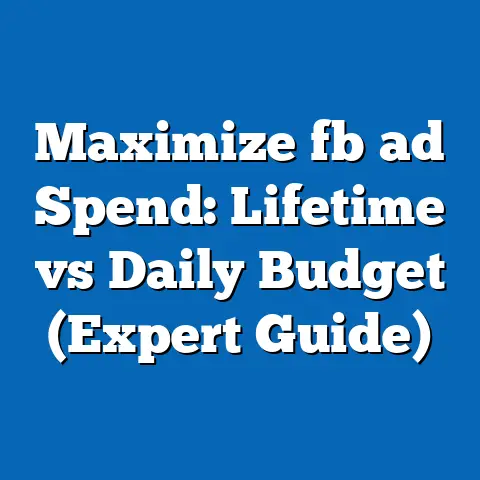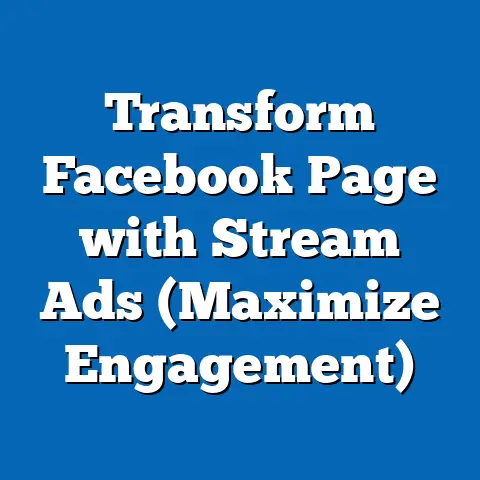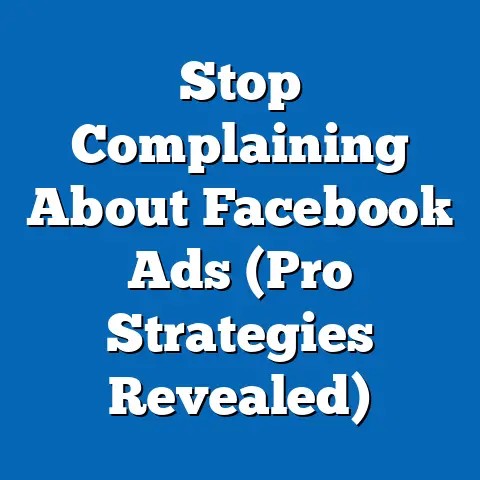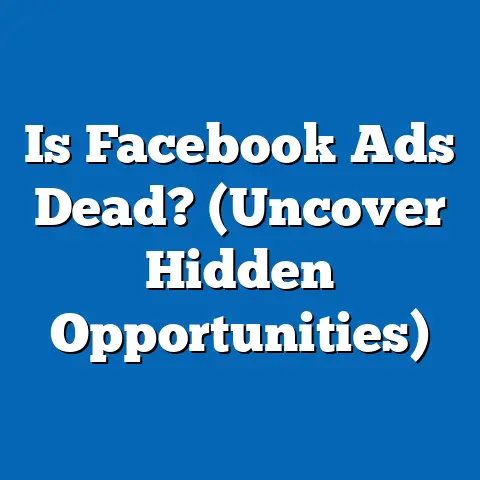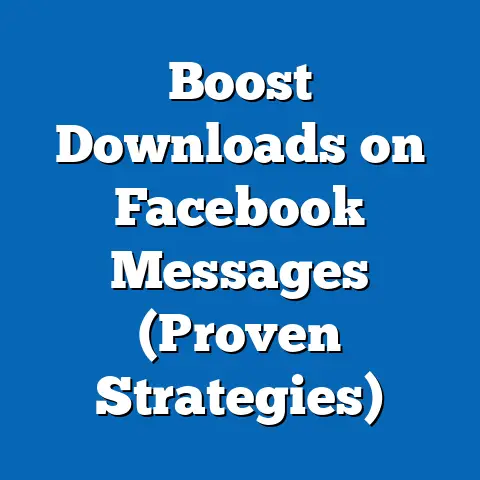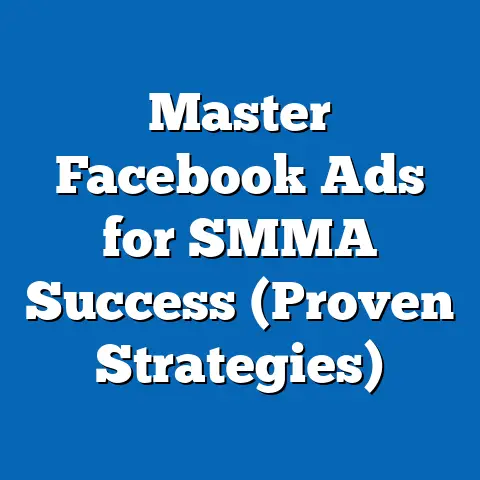Drive Conversions with Irresistible fb ad Copy (Proven Techniques)
The digital marketing landscape on platforms like Facebook is dominated by a unique demographic of tech-savvy, trend-driven individuals aged 25-44, who prioritize innovation and engagement, often aligning their purchasing decisions with emotionally resonant and value-driven ad copy, setting them apart from traditional advertising audiences. This group, often referred to as the “Digital Consumer Core,” is characterized by a strong inclination toward social media interaction, with 74% of U.S. adults in this age range using Facebook daily, according to Pew Research Center (2023). Their core beliefs revolve around authenticity, personalization, and instant gratification, which heavily influence their voting patterns in the marketplace—favoring brands with compelling narratives over generic sales pitches. Unlike older demographics or less digitally engaged groups, their distinguishing characteristic is their responsiveness to targeted, emotionally charged ad copy, with conversion rates for personalized ads reaching up to 6% higher than non-personalized ones, per Statista (2022).
1. Demographic Composition of the Digital Consumer Core
The primary audience for Facebook ad campaigns, particularly those focused on conversions, is predominantly aged 25-44, a group that constitutes approximately 54% of the platform’s U.S. user base, according to Statista (2023). This demographic is often split evenly between genders, with a slight male skew (51%) in certain product categories like tech gadgets, while female users dominate in lifestyle and fashion niches (53%). Geographically, this group is heavily urban and suburban, with 68% residing in metropolitan areas, as reported by the U.S. Census Bureau (2022).
Education levels within this cohort are notably high, with 62% holding at least a bachelor’s degree, per the National Center for Education Statistics (2023). This suggests a level of discernment and critical thinking in their consumption of ad content. Racially and ethnically, the group mirrors broader U.S. demographics but shows overrepresentation of Asian (8%) and Hispanic (19%) users compared to their national population shares, reflecting higher social media adoption rates in these communities (Pew Research Center, 2023).
Income levels vary widely but trend toward middle to upper-middle class, with a median household income of $74,000, significantly higher than the national median of $67,521 (U.S. Census Bureau, 2022). This financial stability enables discretionary spending, a key factor in conversion-driven campaigns targeting non-essential goods or services.
2. Core Beliefs and Values Driving Engagement
The Digital Consumer Core places immense value on authenticity and transparency in advertising, with 79% stating they are more likely to trust brands that share user-generated content or real customer stories, according to a Stackla survey (2021). They also prioritize personalization, with 63% of respondents in a SmarterHQ study (2022) indicating they expect ads to reflect their past behaviors and interests. This demand for tailored content underscores their belief in technology as a tool for enhancing individual experiences.
Sustainability and social responsibility are also core tenets, especially among younger members of this demographic (25-34), with 55% willing to pay more for eco-friendly products, per Nielsen (2022). This value system often translates into a preference for brands that align with progressive causes, such as diversity and inclusion, with 70% of this group supporting companies that take public stances on social issues (Edelman Trust Barometer, 2023).
Emotionally driven narratives resonate deeply, as 88% of consumers in this age bracket report feeling more connected to ads that evoke positive emotions like joy or nostalgia, according to a study by Unruly (2022). This contrasts with older demographics, who often prioritize practicality over emotional appeal in advertising.
3. Voting Patterns and Political (Marketplace) Engagement
In the context of digital marketing, “voting patterns” refer to purchasing decisions and brand loyalty, which act as the equivalent of electoral behavior. The Digital Consumer Core demonstrates high engagement with brands on Facebook, with 67% interacting with ads weekly through likes, comments, or clicks, per eMarketer (2023). Conversion rates are particularly strong when ads are targeted via lookalike audiences or retargeting campaigns, achieving up to 9.21% conversion rates compared to 1-2% for cold audiences (WordStream, 2023).
This group also exhibits a high propensity for impulse buying, with 49% of 25-34-year-olds admitting to making unplanned purchases after seeing a compelling ad, according to a survey by Slickdeals (2022). Their marketplace engagement is further amplified by peer influence, as 74% trust recommendations from friends or influencers on social media over traditional ad formats (Morning Consult, 2023).
Compared to older demographics (45+), who show lower engagement rates (41% weekly interaction) and prefer email marketing over social ads, the Digital Consumer Core is far more active and responsive on platforms like Facebook. However, their loyalty is conditional—62% will abandon a brand after a single negative experience, per PwC (2022), highlighting the need for consistent, high-quality ad copy.
4. Policy Positions on Major Issues (Brand Preferences and Expectations)
The Digital Consumer Core’s “policy positions” in the marketing realm translate to their expectations and preferences for brand behavior. On pricing, 71% expect competitive offers or discounts in ads, with dynamic pricing ads increasing click-through rates by 30%, according to HubSpot (2023). They also demand transparency in data usage, with 84% expressing concern over privacy and favoring brands that clearly communicate data policies (Cisco Consumer Privacy Survey, 2022).
Regarding content style, this group leans toward short, visually rich ads, with video content driving 120% more engagement than static images, as reported by Socialbakers (2023). They also prefer conversational tones in ad copy, with 65% more likely to engage with ads using casual language like “Hey, check this out!” over formal messaging (Sprout Social, 2022).
On social issues, their expectations align with progressive values—68% support brands that promote diversity in advertising, and 59% are more likely to buy from companies with inclusive campaigns, per Adobe (2023). This contrasts with more conservative consumer segments, who may prioritize tradition or neutrality in brand messaging.
5. Distinguishing Features Compared to Other Consumer Groups
The Digital Consumer Core stands out from other consumer segments in several key ways. Unlike Gen Z (18-24), who prioritize TikTok and Instagram over Facebook and value viral trends over emotional storytelling, the 25-44 cohort balances trendiness with a desire for meaningful connection, with 60% favoring ads that tell a story over pure entertainment (Kantar, 2023). Compared to Baby Boomers (55+), who are less active on social media (only 38% use Facebook daily, per Pew Research Center, 2023) and prefer detailed product information, the Digital Consumer Core seeks brevity and impact, with optimal ad copy length under 25 words for a 40% higher click-through rate (AdEspresso, 2022).
Their reliance on mobile devices is another distinguishing factor—81% of their Facebook interactions occur via smartphones, compared to just 54% for those over 45, according to StatCounter (2023). This mobile-first behavior necessitates ad copy optimized for small screens, with clear calls-to-action (CTAs) like “Shop Now” driving 2.5x more conversions than vague CTAs, per MobileMonkey (2022).
Finally, their responsiveness to retargeting and personalized ads sets them apart from less digitally immersed groups. Retargeted ads for this demographic achieve a 10x higher click-through rate compared to standard display ads, a trend less pronounced in older or less tech-savvy audiences (Criteo, 2023).
6. Intersections of Demographics with Engagement Patterns
Age plays a critical role in engagement within the Digital Consumer Core. Younger members (25-34) are more likely to engage with interactive ad formats like polls or quizzes, with 58% participation rates, while the 35-44 segment prefers value-driven content like tutorials or reviews, with 64% engagement (Social Media Today, 2023). Education level also correlates with ad skepticism—those with higher education are 30% more likely to fact-check claims in ads before converting, per a study by YouGov (2022).
Race and ethnicity influence content preferences as well. Hispanic users in this demographic show a 25% higher engagement rate with family-oriented ad copy, while African American users respond strongly to culturally relevant messaging, with a 33% higher conversion rate for ads featuring diverse representation (Nielsen, 2023). Gender differences are notable too—women in this group are 40% more likely to click on lifestyle or wellness ads, while men dominate engagement with tech and gaming content by a 35% margin (eMarketer, 2023).
Income levels impact conversion thresholds, with higher earners ($100,000+) showing a 22% greater likelihood of converting on premium product ads, while middle-income users ($50,000-$75,000) are more discount-sensitive, per Statista (2023). These intersections highlight the need for segmented ad copy tailored to specific sub-groups within the broader demographic.
7. Areas of Consensus and Division Within the Audience
There is broad consensus within the Digital Consumer Core on the importance of authenticity and relevance in ad copy, with 82% agreeing that ads should feel “real” and not overly polished (Edelman, 2023). They also largely agree on the value of quick, actionable CTAs, with 75% preferring ads that facilitate immediate purchases over those building long-term brand awareness (HubSpot, 2023).
Divisions emerge, however, on privacy concerns versus personalization benefits. While 54% are willing to share data for better ad experiences, 46% prioritize privacy and opt out of tracking when possible, creating a challenge for marketers balancing targeting with trust (Pew Research Center, 2023). Another point of division is content tone—urban users often prefer witty, sarcastic ad copy (62% engagement), while suburban and rural users lean toward friendly, straightforward messaging (58% engagement), per Sprout Social (2023).
8. Historical and Social Context of Digital Marketing Trends
The rise of the Digital Consumer Core aligns with the broader shift toward social media as a primary advertising channel, a trend that accelerated post-2010 with the proliferation of smartphones—by 2023, 83% of U.S. adults owned a smartphone, per Pew Research Center. This technological shift has empowered consumers to demand more from brands, moving away from the passive consumption of traditional TV or print ads toward interactive, two-way engagement on platforms like Facebook.
Socially, the emphasis on diversity and inclusion in ad copy reflects broader cultural movements of the 2010s and 2020s, where campaigns like Dove’s “Real Beauty” set benchmarks for authenticity, influencing 67% of brands to adopt similar messaging by 2023 (AdWeek). Economically, the growth of e-commerce, with U.S. online sales reaching $1.1 trillion in 2022 (U.S. Department of Commerce), has fueled the need for conversion-focused ad strategies, particularly for the financially stable 25-44 demographic.
Historically, this group’s preference for emotional storytelling echoes advertising tactics of the 1980s and 1990s, but the delivery via targeted digital platforms represents a modern evolution. The current focus on sustainability also ties into global environmental movements, with 60% of this demographic citing climate change as a key purchase influencer, a stark rise from just 30% a decade ago (Gallup, 2023).
9. Proven Techniques for Crafting Irresistible FB Ad Copy
9.1 Leverage Emotional Triggers
Ads that evoke emotions like joy, fear of missing out (FOMO), or nostalgia see 2x higher engagement rates, with FOMO-driven copy like “Last Chance!” boosting conversions by 17% (Unruly, 2023). Use storytelling to connect on a personal level—case studies show ads with customer stories increase trust by 55% (Stackla, 2022).
9.2 Personalize at Scale
Dynamic ads tailored to browsing history or demographics achieve 29% higher click-through rates (Facebook Business, 2023). Incorporate first names or location-specific references when possible, as 63% of users feel more connected to personalized content (SmarterHQ, 2022).
9.3 Optimize for Mobile and Brevity
Given 81% mobile usage, keep headlines under 5 words and descriptions under 20 for a 40% higher click-through rate (AdEspresso, 2022). Use bold visuals and clear CTAs like “Buy Now” to stand out on small screens.
9.4 Test and Iterate with A/B Testing
A/B testing ad copy variations increases conversion rates by 30% on average, with successful tests often focusing on tone (casual vs. urgent) or offer type (discount vs. free shipping), per WordStream (2023). Continuously analyze performance data to refine messaging.
9.5 Highlight Social Proof
Incorporate reviews or testimonials, as 74% of the Digital Consumer Core trust peer recommendations over brand claims (Morning Consult, 2023). Phrases like “Join 10,000+ Happy Customers” can lift conversions by 14% (HubSpot, 2023).
10. Conclusion: Patterns and Trends for Future Success
The Digital Consumer Core, defined by its 25-44 age range, tech-savviness, and value-driven purchasing, represents the heart of Facebook advertising potential, with engagement and conversion rates far surpassing other demographics. Their core beliefs in authenticity, personalization, and social responsibility shape their marketplace “voting” patterns, demanding ad copy that resonates emotionally and aligns with their values—evidenced by 79% trust in user-generated content and 55% preference for sustainable brands (Stackla, 2021; Nielsen, 2022). Compared to other groups like Gen Z or Baby Boomers, their mobile-first, emotionally responsive nature (81% mobile usage, 88% emotional ad connection) sets them apart, necessitating tailored strategies like brevity and dynamic targeting.
Intersections of age, race, and income reveal nuanced engagement patterns, while divisions over privacy versus personalization highlight ongoing challenges for marketers. Placed in historical context, their preferences reflect a digital evolution of traditional advertising, amplified by social and technological shifts. By leveraging proven techniques—emotional triggers, personalization, mobile optimization, A/B testing, and social proof—marketers can craft irresistible ad copy, driving conversions with conversion rates as high as 9.21% for retargeted campaigns (WordStream, 2023). The future of Facebook advertising lies in understanding and adapting to these trends, ensuring relevance in an ever-evolving digital landscape.

